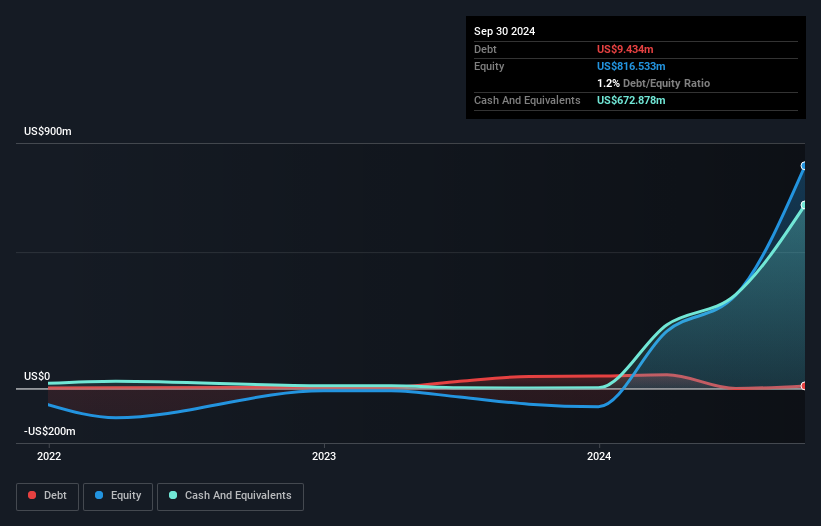Is Trump Media & Technology Group (NASDAQ:DJT) Using Too Much Debt?
The external fund manager backed by Berkshire Hathaway's Charlie Munger, Li Lu, makes no bones about it when he says 'The biggest investment risk is not the volatility of prices, but whether you will suffer a permanent loss of capital.' When we think about how risky a company is, we always like to look at its use of debt, since debt overload can lead to ruin. We note that Trump Media & Technology Group Corp. (NASDAQ:DJT) does have debt on its balance sheet. But the real question is whether this debt is making the company risky.
When Is Debt A Problem?
Debt and other liabilities become risky for a business when it cannot easily fulfill those obligations, either with free cash flow or by raising capital at an attractive price. Ultimately, if the company can't fulfill its legal obligations to repay debt, shareholders could walk away with nothing. However, a more usual (but still expensive) situation is where a company must dilute shareholders at a cheap share price simply to get debt under control. Having said that, the most common situation is where a company manages its debt reasonably well - and to its own advantage. The first thing to do when considering how much debt a business uses is to look at its cash and debt together.
See our latest analysis for Trump Media & Technology Group
How Much Debt Does Trump Media & Technology Group Carry?
You can click the graphic below for the historical numbers, but it shows that Trump Media & Technology Group had US$9.43m of debt in September 2024, down from US$43.9m, one year before. However, its balance sheet shows it holds US$672.9m in cash, so it actually has US$663.4m net cash.

A Look At Trump Media & Technology Group's Liabilities
According to the last reported balance sheet, Trump Media & Technology Group had liabilities of US$14.4m due within 12 months, and liabilities of US$6.86m due beyond 12 months. Offsetting this, it had US$672.9m in cash and US$14.8k in receivables that were due within 12 months. So it actually has US$651.7m more liquid assets than total liabilities.
This surplus suggests that Trump Media & Technology Group has a conservative balance sheet, and could probably eliminate its debt without much difficulty. Succinctly put, Trump Media & Technology Group boasts net cash, so it's fair to say it does not have a heavy debt load! When analysing debt levels, the balance sheet is the obvious place to start. But it is Trump Media & Technology Group's earnings that will influence how the balance sheet holds up in the future. So if you're keen to discover more about its earnings, it might be worth checking out this graph of its long term earnings trend.
Over 12 months, Trump Media & Technology Group made a loss at the EBIT level, and saw its revenue drop to US$3.4m, which is a fall of 27%. That makes us nervous, to say the least.
So How Risky Is Trump Media & Technology Group?
Statistically speaking companies that lose money are riskier than those that make money. And we do note that Trump Media & Technology Group had an earnings before interest and tax (EBIT) loss, over the last year. And over the same period it saw negative free cash outflow of US$64m and booked a US$372m accounting loss. While this does make the company a bit risky, it's important to remember it has net cash of US$663.4m. That means it could keep spending at its current rate for more than two years. Overall, its balance sheet doesn't seem overly risky, at the moment, but we're always cautious until we see the positive free cash flow. When analysing debt levels, the balance sheet is the obvious place to start. However, not all investment risk resides within the balance sheet - far from it. We've identified 5 warning signs with Trump Media & Technology Group (at least 3 which are concerning) , and understanding them should be part of your investment process.
At the end of the day, it's often better to focus on companies that are free from net debt. You can access our special list of such companies (all with a track record of profit growth). It's free.
Valuation is complex, but we're here to simplify it.
Discover if Trump Media & Technology Group might be undervalued or overvalued with our detailed analysis, featuring fair value estimates, potential risks, dividends, insider trades, and its financial condition.
Access Free AnalysisHave feedback on this article? Concerned about the content? Get in touch with us directly. Alternatively, email editorial-team (at) simplywallst.com.This article by Simply Wall St is general in nature. We provide commentary based on historical data and analyst forecasts only using an unbiased methodology and our articles are not intended to be financial advice. It does not constitute a recommendation to buy or sell any stock, and does not take account of your objectives, or your financial situation. We aim to bring you long-term focused analysis driven by fundamental data. Note that our analysis may not factor in the latest price-sensitive company announcements or qualitative material. Simply Wall St has no position in any stocks mentioned.
免責聲明:投資有風險,本文並非投資建議,以上內容不應被視為任何金融產品的購買或出售要約、建議或邀請,作者或其他用戶的任何相關討論、評論或帖子也不應被視為此類內容。本文僅供一般參考,不考慮您的個人投資目標、財務狀況或需求。TTM對信息的準確性和完整性不承擔任何責任或保證,投資者應自行研究並在投資前尋求專業建議。
熱議股票
- 1
- 2
- 3
- 4
- 5
- 6
- 7
- 8
- 9
- 10